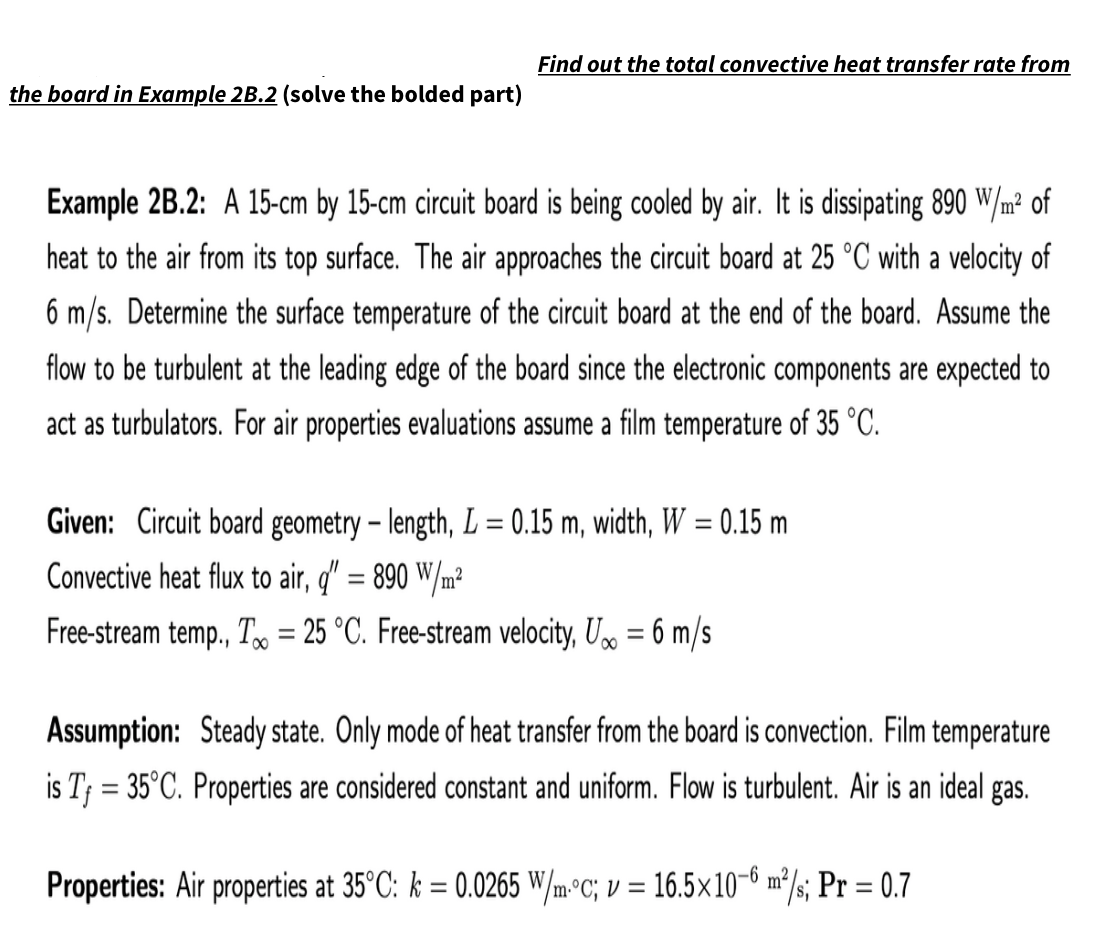Example 2B.2: A 15-cm by 15-cm circuit board is being cooled by air. It is dissipating 890 W/m² of heat to the air from its top surface. The air approaches the circuit board at 25 °C with a velocity of 6 m/s. Determine the surface temperature of the circuit board at the end of the board. Assume the flow to be turbulent at the leading edge of the board since the electronic components are expected to act as turbulators. For air properties evaluations assume a film temperature of 35 °C. Given: Circuit board geometry – length, L = 0.15 m, width, W = 0.15 m Convective heat flux to air, q'" = 890 W/m² Free-stream temp., T = 25 °C. Free-stream velocity, U» = 6 m/s %3D Assumption: Steady state. Only mode of heat transfer from the board is convection. Film temperature is T; = 35°C. Properties are considered constant and uniform. Flow is turbulent. Air is an ideal gas. Properties: Air properties at 35°C: k = 0.0265 W/m°C; v = 16.5×10-6 m²/s; Pr = 0.7 %3D
Example 2B.2: A 15-cm by 15-cm circuit board is being cooled by air. It is dissipating 890 W/m² of heat to the air from its top surface. The air approaches the circuit board at 25 °C with a velocity of 6 m/s. Determine the surface temperature of the circuit board at the end of the board. Assume the flow to be turbulent at the leading edge of the board since the electronic components are expected to act as turbulators. For air properties evaluations assume a film temperature of 35 °C. Given: Circuit board geometry – length, L = 0.15 m, width, W = 0.15 m Convective heat flux to air, q'" = 890 W/m² Free-stream temp., T = 25 °C. Free-stream velocity, U» = 6 m/s %3D Assumption: Steady state. Only mode of heat transfer from the board is convection. Film temperature is T; = 35°C. Properties are considered constant and uniform. Flow is turbulent. Air is an ideal gas. Properties: Air properties at 35°C: k = 0.0265 W/m°C; v = 16.5×10-6 m²/s; Pr = 0.7 %3D
Principles of Heat Transfer (Activate Learning with these NEW titles from Engineering!)
8th Edition
ISBN:9781305387102
Author:Kreith, Frank; Manglik, Raj M.
Publisher:Kreith, Frank; Manglik, Raj M.
Chapter6: Forced Convection Over Exterior Surfaces
Section: Chapter Questions
Problem 6.8P
Related questions
Question
Corection the following number k=.02625,Kinematic viscosity(fancy v)=16.55*10^-6m^2/s,Pr=.7
Re(x=L)=54380
Nu(x)=170.1
h(x=L)=29.8
Ts(l)=54.9C

Transcribed Image Text:Find out the total convective heat transfer rate from
the board in Example 2B.2 (solve the bolded part)
Example 2B.2: A 15-cm by 15-cm circuit board is being cooled by air. It is dissipating 890 W/m² of
heat to the air from its top surface. The air approaches the circuit board at 25 °C with a velocity of
6 m/s. Determine the surface temperature of the circuit board at the end of the board. Assume the
flow to be turbulent at the leading edge of the board since the electronic components are expected to
act as turbulators. For air properties evaluations assume a film temperature of 35 °C.
Given: Circuit board geometry – length, L = 0.15 m, width, W = 0.15 m
Convective heat flux to air, q' = 890 W/m²
Free-stream temp., T = 25 °C. Free-stream velocity, U» = 6 m/s
Assumption: Steady state. Only mode of heat transfer from the board is convection. Film temperature
is T¡ = 35°C. Properties are considered constant and uniform. Flow is turbulent. Air is an ideal gas.
Properties: Air properties at 35°C: k = 0.0265 W/m°C; v = 16.5×10-6 m²/s; Pr = 0.7
Expert Solution
This question has been solved!
Explore an expertly crafted, step-by-step solution for a thorough understanding of key concepts.
Step by step
Solved in 2 steps with 2 images

Knowledge Booster
Learn more about
Need a deep-dive on the concept behind this application? Look no further. Learn more about this topic, mechanical-engineering and related others by exploring similar questions and additional content below.Recommended textbooks for you

Principles of Heat Transfer (Activate Learning wi…
Mechanical Engineering
ISBN:
9781305387102
Author:
Kreith, Frank; Manglik, Raj M.
Publisher:
Cengage Learning

Principles of Heat Transfer (Activate Learning wi…
Mechanical Engineering
ISBN:
9781305387102
Author:
Kreith, Frank; Manglik, Raj M.
Publisher:
Cengage Learning